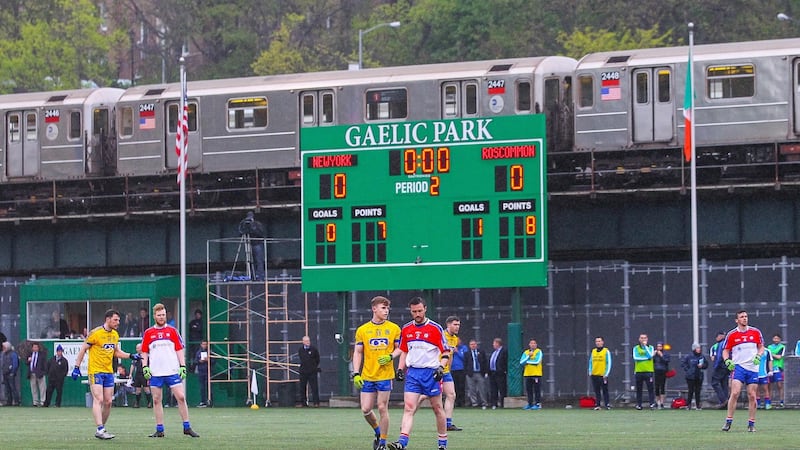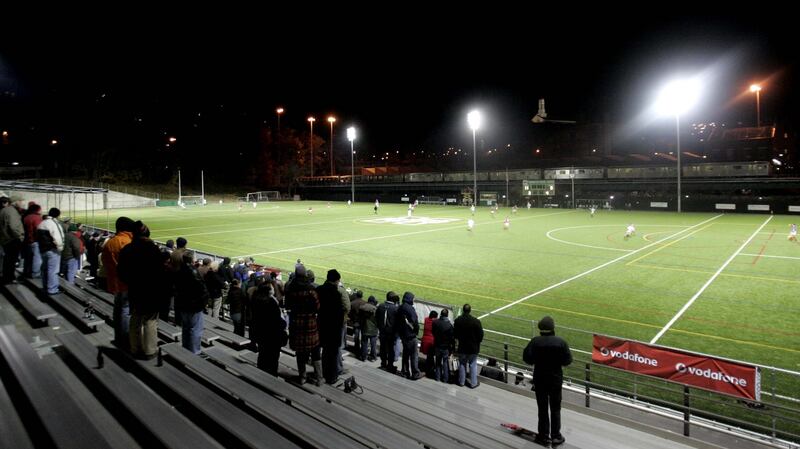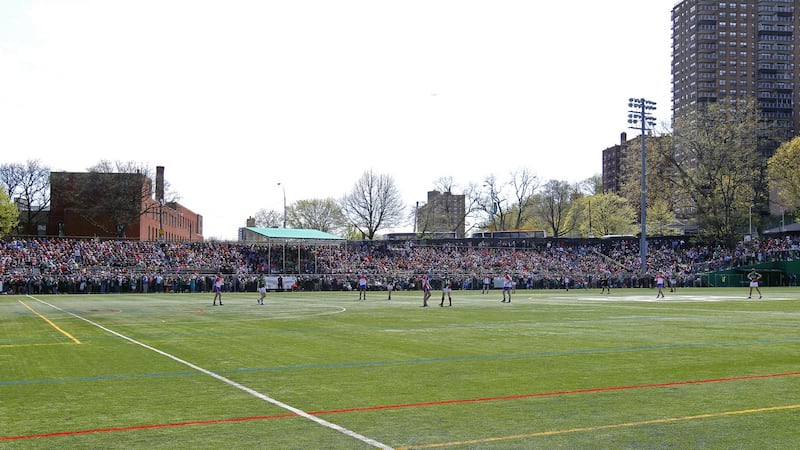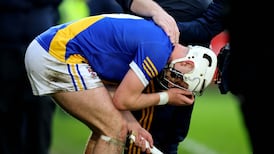In the National Football League final of 1950, a teenager named Jackie Hughes played centre-forward for New York in their win over Cavan.
Hughes was symbolic of the future for Gaelic games in the metropolis; city born and suitably accented but guided towards Gaelic games through the teeming minor leagues which thrived during the second World War.
“I’m trying to see if that kid is still alive,” says Simon Gillespie. “Well, he wouldn’t be a kid now. He’d be 86. I know he was keeping well four of five years ago. But he hasn’t been heard from in a while.”
Hughes belongs to the vast chorus of distinguished footballers to have passed through Gaelic Park, the dauntless time capsule just a few minutes’ walk from the 240th street station in the Bronx.
Gillespie is New York’s GAA development officer and has become fascinated by the radical swings in fortune and health experienced by the entity through the decades. He is researching a project on the minor board in New York.

Jackie Hughes grew up in a decade when the GAA ran a minor competition that had teams from 20 different parishes; the game was thriving.
“But not long after that, the minor board ended and the league didn’t exist anymore.”
For better or worse, Gaelic Park has always been the touchstone for GAA in New York. This year, New York GAA will celebrate 90 years residency at the ground and, just this week, they received signed papers from the MTA that passes the official leasehold over to them.
Already, the New York board have received completed plans from architects for a new clubhouse, ballroom, dressing rooms, conferences rooms and offices for the local development officers and the Ladies GAA board. Work is scheduled to begin in June. By next March, the new Gaelic Park will be complete. The GAA has contributed $2 million to the project.
Like everyone who has walked up the sloping hill towards Gaelic Park, Simon Gillespie was underwhelmed when he first laid eyes on the place. It’s steadfastly rooted in another time, with the unadorned sign above the door and the period brickwork and the poorly lighted bar. You’re not long in the place before you realise that a lot of stories have been told under the low roof.
Gillespie came to New York in 2010 and first visited Gaelic Park to play a midweek game with Donegal junior team; the place was quiet and felt sort of forlorn.
Really special
“It wasn’t state of the art, now. I was a little unimpressed. But then, the more you come along and you talk to the old guys down at the field; the way they talk of games from 20 or 30 years ago – guys like Séamus Collins from Kerry and Tommy Treanor from Armagh – and they were talking about these players in a way that you’d swear they were playing in front of you; they were like ghosts of a bygone era and you could feel the history around the place even though the facility itself was unremarkable. So the memories there hold a really special, you know, emotion for that generation.”
And it’s true, the point of Gaelic Park has never been the actual stadium, it is what it means to people. The venue has never been anything special to look at yet no GAA stadium apart from Croke Park has hosted so many all-time great hurlers and footballers.
Gaelic Park stands alone as the only GAA ground that had Christy Ring and Robert F Kennedy walk through the gates on the same afternoon and is the only GAA ground to host concerts by both the Grateful Dead and Deep Purple.
Three National Football League-winning teams and two hurling final runners-up emanated from Gaelic Park It was in Gaelic Park that Kerry legend Mick O’Connell engaged Roy Garella, the Pittsburgh Steelers kicker, in a kicking contest and won 7-6.

The Sam Maguire vanished from the clubhouse one night when Feale Rangers and Kerry captain Jimmy Deenihan were touring. The cup had been left in the clubhouse overnight for safekeeping but couldn’t be found in the morning, forcing the Kerry men to continue on their tour without the trophy.
It wasn’t until the FBI began to make enquiries that the Sam Maguire reappeared as suddenly as it had vanished. Gargantuan crowds used to show up for local championship games in the 1950s and 1960s and again in the 1980s, when a series of rows over the gate fee led to cancellations and postponements.
John ‘Kerry’ O’Donnell, the godfather of the New York game and official leaseholder of Gaelic Park, simply refused to raise the entrance fee by a dollar. In 1987 the New York final between Connemara and Donegal – whose star forward was Larry Tompkins – ended in a draw and a bumper crowd was expected for the replay.
However, a stand-off between the county board and O’Donnell over which party should handle the turnstiles led to a series of postponements and a vengeful winter had descended before a compromise was reached. The game was never played.
Gaelic Park has probably hosted more brawls and melees per square yard than any other GAA ground on earth. It was referenced as “The Bloodpit of the Bronx” by a New York sports columnist decades before the 1970 visit by then All-Ireland champions Cork for an exhibition which ended 5-21 to 6-16 in favour of the visitors and an after-match row which left the referee, Clem Foley, with a broken jaw.
New arrivals
When a New York party visited Ireland for an already-scheduled tour that autumn, relations were strained and there was no official central council figure to greet the visiting team at a warm-up game in O’Kennedy Park in New Ross.
“As guests in this country, we feel we are snubbed,” declared Sean O’Hanlon, the New York board president. The games were cancelled and the tourists left again harbouring feelings of resentment that ran both ways. The GAA moved to sever ties with New York for a period of two years. It didn’t matter, New York simply got on with it. But those were just the games. The real purpose of Gaelic Park lay in its role as a sort of safe-house for new arrivals.
“I think Gaelic Park means a lot to many Irish people who came here,” says Lawrence McGrath, the chairman of the New York board which brokered the deal with the MTA.
“I know when I came to New York, it felt like a very big place. You were very far from home. It felt just like a large family. People I met the first year I came out and since then became my best friends. But when people are young, too, and looking for work or accommodation . . . .a lot of people fall on hard times and a lot of young Irish people might have been picked up at Gaelic Park and got a place to lie until they found their feet and got work. Let alone how many met wives and husbands at Gaelic Park. I think it does still serves that role.
It is very difficult now to get a visa for the United States. So I feel we will have a lot of challenges ahead at the senior board
“The championship game is the big game of the year. And the place will be packed for the Leitrim game on May 6th. Look, there isn’t as much immigration as there was in previous decades. But there still is immigration and it can be a lonely city when you come out here. And the new Gaelic Park isn’t going to be just about the bar and ballroom. It will be an Irish centre where people can gather. And that’s hugely important.”
In 1978 the broadcaster Cathal Ó Griofa produced and presented an RTÉ Radio One documentary from Gaelic Park which featured an extended interview with O’Donnell. He was there in deep winter, it was bitterly-cold and icy and nothing going on by way of Gaelic games. O’Donnell was wonderfully sharp and off-the-cuff but while the interview is valuable, Ó Griofa’s closing description of a humdrum winter’s evening in the Gaelic Park bar is the definitive snapshot of the place in the O’Donnell era.
“And so typically and sardonically,” Ó Griofa tells his audience, “John Kerry O’Donnell ended our conversation in Gaelic Park and within seconds – and this may be one of the badges of his success – the tall, spare figure was mingling casually, or so it seemed, with the hundreds who had come to see the aborted game. The pitch, brown and grey and dirty snow-white in patches, was soon freezing in the short New York spring dusk; a strange oasis of burnt grass and stone in the middle of the concrete impersonal desolation of the Bronx.
Endless bar
“Gaelic Park closed its doors and drew its customers into the warmth of the long and seemingly endless bar. Fathers, mothers, aunts, uncles’ children big and small, sipping. Sipping shorts – bourbons, scotch-on-the-rocks, Paddies, Cokes so ice-shot in typically American fashion that you couldn’t find the coke and talking, always talking; flat rounded Munster accents perforated here and there by the short staccato rattle of a few footballers from Carrickmore in Tyrone.
“Everyone is going home. Home to Ireland. Some have gone and some have come back. One man sipping a short and a pint looked nostalgically at the long bar and talked somewhat sadly of the 1950s. The Irish at home were, well, not quite what he expected. Not as warm; not as friendly. Cost of living too high. Not as neighbourly as before.
“What time do you close?” I asked the barman.
“All depends,” was his helpful reply. By 6.30 in the evening it was dark. Street lights, yellow and menacing, poked opaquely through the warm windows and towards the bar counter. John Kerry looked at his watch. Like starlings they all rose.”

Habits change. Larry McCarthy, a former chairman of the New York board and a lecturer in Seton Hall, laughs that Irish-Americans often refer to new immigrants as the ‘i-Paddies.”
“These guys are well-educated, connected and don’t need Gaelic Park in the way earlier generations did. And that’s all for the good. But they still want to play the games. People sometimes talk about “keeping it going” in New York. Stop! Stop! We are engaged in it and we are growing it and we love it. The volunteer aspect is probably a bigger issue for New York because it is a relatively transient society here. There are challenges. But I think the relationship between the GAA at home and New York has never been better.”
One of the key challenges lies in trying to predict the consequence of emigration patterns on numbers playing the game.
Right now, Simon Gillespie is organising coaching for Irish-American kids of Irish people who arrived in the boroughs in the late 1990s and early 2000s and made a home there. But since 2005, the numbers of Irish migrating to New York have dropped significantly.
“And it is very difficult now to get a visa for the United States. So I feel we will have a lot of challenges ahead at the senior board. But about 50 per cent of those now playing in the senior leagues are graduates of the minor board programme. We are relying on those Irish-Americans to fill the gap. The old H1B visa has almost dried up.”
As always with New York GAA, the key to the future can be found in the past. If the gala weekends of weekend county stars landing out for a one-off appearance are over; if the sight of 10,000 people exiting the Broadway train on county final day in Gaelic Park are done and dusted, then a thriving minor board and nurturing more American-born players like Jackie Hughes – wherever he is – may be the way forward for the GAA’s lone star state.











